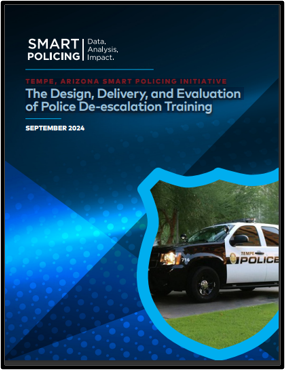
De-escalation training has emerged as a strategy that many believe can reduce the use of unlawful and unnecessary force by police officers. Despite de-escalation’s rapid adoption in policing, its evidence base is both limited and mixed. As a result, key questions about its impact remain unanswered. In 2017, the Tempe, Arizona Police Department (TPD) and researchers from Arizona State University (ASU) received funding through the Bureau of Justice Assistance (BJA) Smart Policing Initiative (SPI) to design, deliver, and evaluate a de-escalation training program. This SPI Spotlight publication highlights the development, implementation, and evaluation of Tempe's efforts and provides a checklist of issues to consider for fellow agencies considering similar programs.
The Tempe SPI team customized its own training. The Tempe team devoted 18 months to curriculum development, centered on three activities:
- Sending officers to attend two dozen different de-escalation trainings to hand-pick what would work for Tempe.
- Identifying and learning from “top de-escalators” in TPD.
- Conducting a departmentwide survey to gather perspectives about de-escalation from all officers. The SPI team collated information from these activities and worked with curriculum developers to create the training content.
The training is grounded in officer safety and wellness and has four guiding pillars: • Officer pre-care (work/life balance, sleep, coping mechanisms, etc.). • Officer self-management (emotional intelligence, managing your emotions, etc.). • Managing resources (relieving a colleague when needed, awareness of resources, etc.). • Resiliency (post-incident debriefs, time to decompress, peer support, etc.)
The Tempe SPI team carried out a randomized controlled trial (RCT) comparing outcomes among officers in squads randomly assigned to receive or not receive the training. ASU researchers used a range of data and methods to measure the impact of training, including analysis of use of force data and review of body-worn camera footage, and community member surveys.
- Trained officers were more likely to use procedural justice, emotional regulation, and de-escalation.
- Trained officers were more likely to leave community members satisfied with how they were treated, and with how their encounter was resolved.
- Trained officers decreased their use of certain force types likely to produce injury (e.g., strikes, takedowns). Trained officers spent significantly more time on scene for use of force encounters.
- Trained officers were 58 percent less likely to injure community members when using force.
- All these changes occurred with no increased risk of injury to officers who received the de-escalation training.
The Tempe SPI experience provides the foundation for a de-escalation training checklist. The checklist provides more than a dozen specific and actionable recommendations for agencies engaged in the planning, delivery, and evaluation of de-escalation training.
